Okinawa is well known as Japan’s tropical paradise thanks to its Pacific Ocean setting and mild climate. Okinawa’s beaches range from remote rocky coves to urban beaches with every facility you might need. Whether you’re a surfer, swimmer, or a sunbather, you can find the perfect stretch of sand.
Well, perfect until you think there might be an even better one around the next headland. But, with some 130 beaches on Okinawa Honto (the main island) alone, you may never stop looking.
Here are the 12 best beaches in Okinawa to explore in easy reach of Naha on Okinawa Island, where most visitors arrive.
Tropical Beach, Naha
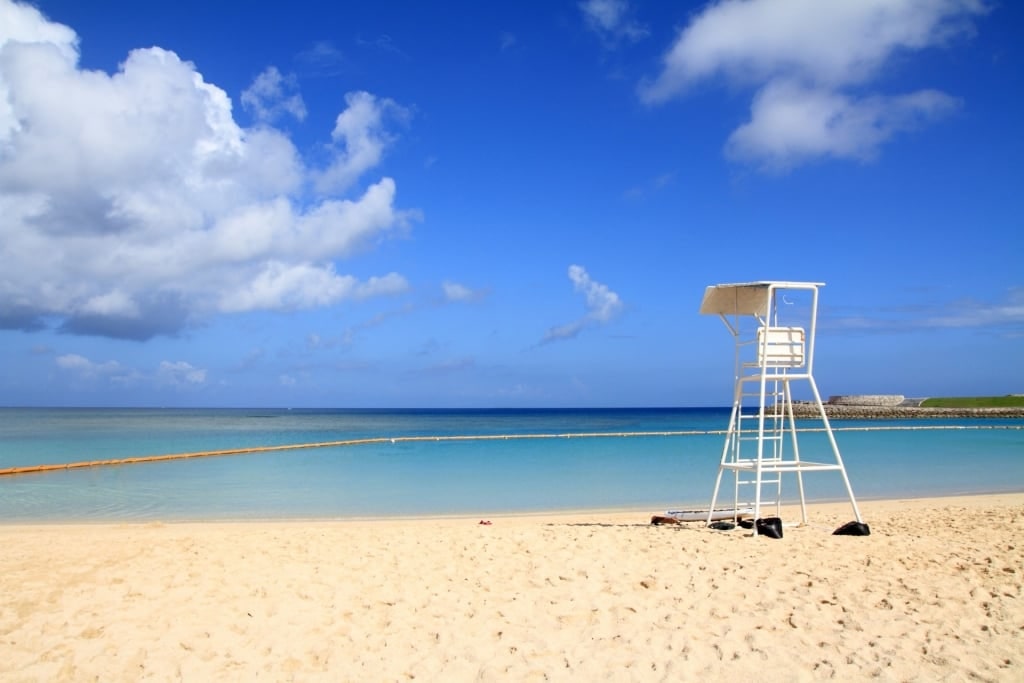
Tropical Beach, Naha
Tucked away behind the Okinawa Convention Center, this artificial white sand beach is popular with locals. A headland and a special boom keep its clear blue waters calm, and clear of the jellyfish that can sometimes be a nuisance here.
For visitors, it’s a place to enjoy a quick swim or snorkel only a short distance from Ginowan City. Showers, restrooms, and lockers are available, and lifeguards are on duty from April to October.

Tropical Beach, Naha
Many Japanese come here to rent a sheltered barbecue space and enjoy a party. The beach is part of the Ginowan Seaside Park, which has facilities for baseball, tennis and other sports.
There is also a jogging trail, while a walking route takes you round the nearby Ginowan Marina. You’ll also find plenty of shops, cafés and restaurants in the area.
Nishihara Kira Kira Beach, Naha
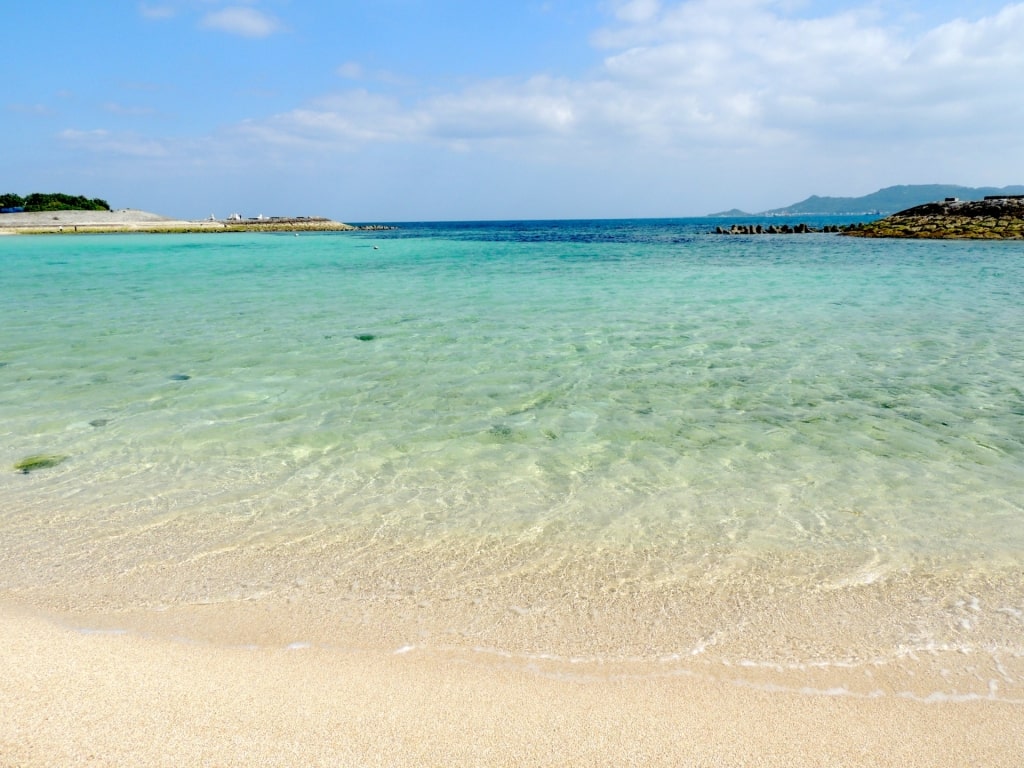
Nishihara Kira Kira Beach, Naha
Nishihara Yonabaru Marine Park is a large complex with facilities for all sorts of activities, from BBQ to soccer. Kira Kira Beach is a long stretch of soft white sand fronting the park.
The beach has a boom with nets to keep out jellyfish. That helps make it very popular with families, but it’s also enjoyed by walkers, volleyballers, and swimmers.

Nishihara Kira Kira Beach, Naha
You can enjoy watersports here, such as banana boat rides, and water scooters, and as such, snorkeling is prohibited for safety reasons. With food stalls, showers, and washrooms, it’s also a good place for picnics or barbecues.
The park has fields for sports, including baseball, and putter golf. If you just want to walk around the beach or park, there are shady gazebos where you can enjoy views over the ocean.
Kira Kira Beach has lifeguards from April through October but is open all year. There are a number of restaurants beside the park, with several more in the nearby Marine Plaza.
Mibaru Beach, Nanjo
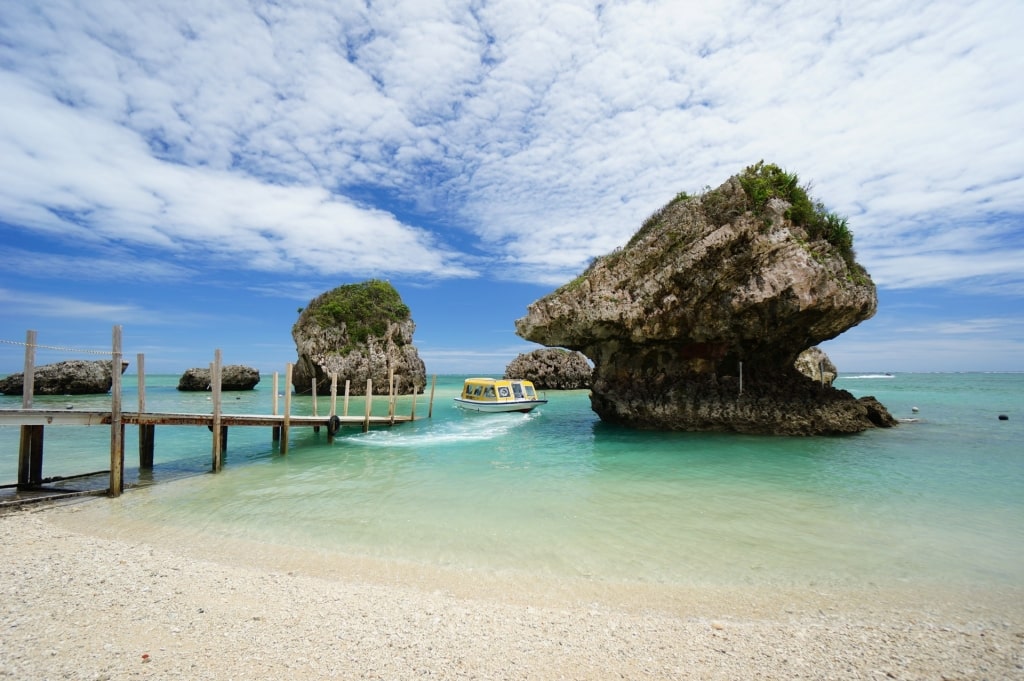
Mibaru Beach, Nanjo
Pass under the blue arch marking the entrance to Mibaru Beach, and you enter Okinawa Honto’s most scenic beach. “Mushroom” rocks and coral reefs just offshore lend it a mystical air at low tide.
This quiet beach on the southeastern coast is more than a mile long, with an arc of shell-strewn sand. Tidal pools hold crabs and other shellfish, and the gently shelving shallows are perfect for paddling.
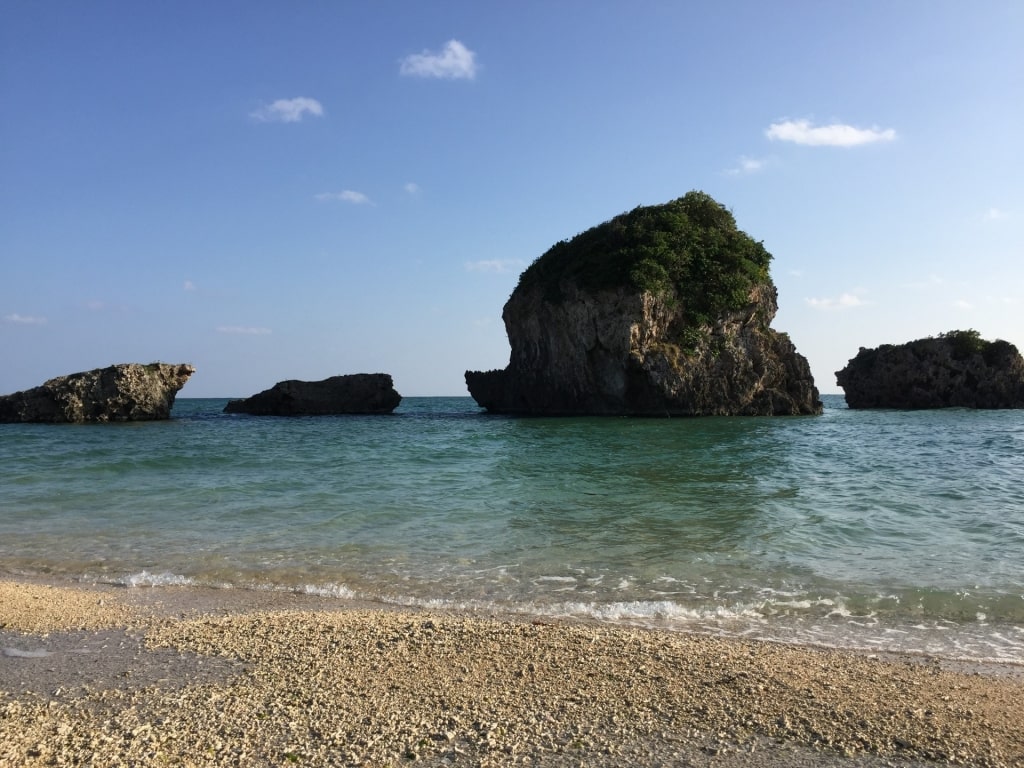
Mibaru Beach, Nanjo
Swimming and snorkeling are great ways to explore more of the reef life, or glass-bottomed boats offer tours. There are showers and lockers, and you can rent snorkels and masks.
There are Japanese food vendors on the beach during the high season (April to October), and a popular Nepalese restaurant, Shokudo Kalika. Overlooking the beach, it’s noted for its curries, lassis, and chai.
Naminoue Beach, Naha

Naminoue Beach, Naha
Dominating this beach is Naminoue-gu Shrine, Okinawa’s most important Shinto shrine. Shinto is closely linked to nature, and this beach is a welcome natural oasis amid the urban sprawl of Naha.
Overlooked by a highway, it does not initially fit the image you might have of one of the best beaches in Okinawa. However, it’s the only place to swim in Naha, and that makes a big difference on a hot day.

Naminoue Beach, Naha
The beach is protected by a boom to keep out jellyfish and watched over by lifeguards. The shrine, and the park behind the beach, are both good places to take a break from the sun.
You’ll notice at any beach that the Japanese do prefer to cover up in the sun, but don’t let that put you off wearing your normal beach attire. However, it’s best to cover larger tattoos as a point of etiquette, and you’ll obviously need more modest clothing here if you visit the shrine.
Cape Maeda, Onneto
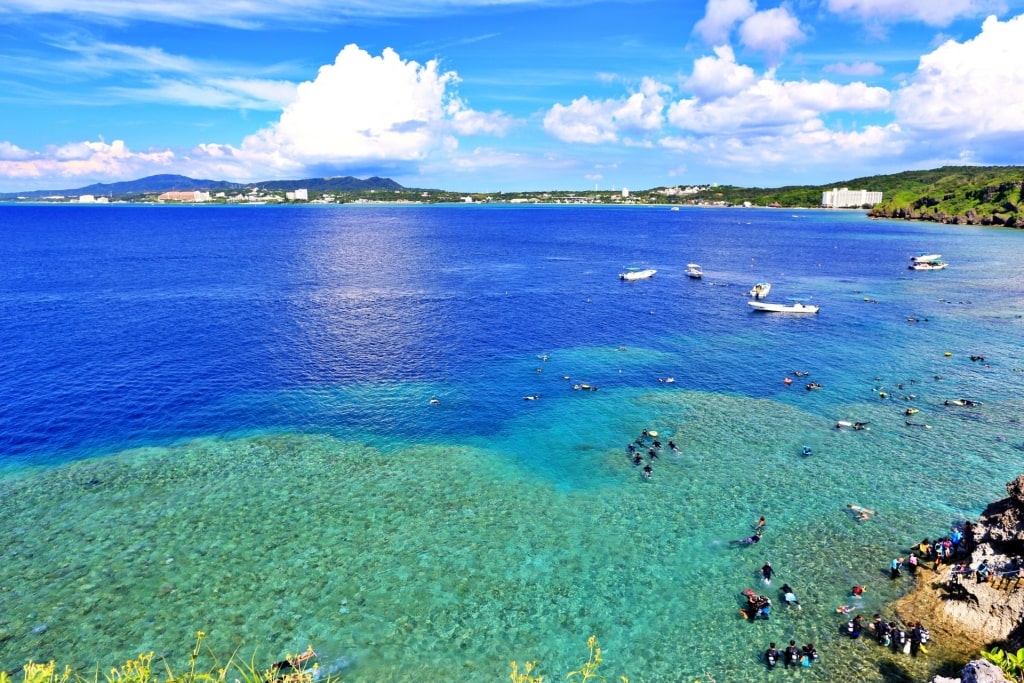
Cape Maeda, Onneto
Cape Maeda has a justified reputation as the best diving in Okinawa. Less than an hour from Naha, it’s also great for snorkelers and swimmers.
It’s a long stairway down to the water, although many come here just for the scenic views from the cliffs. The effort is well worth it though, with a coral reef just offshore when you reach the beach.
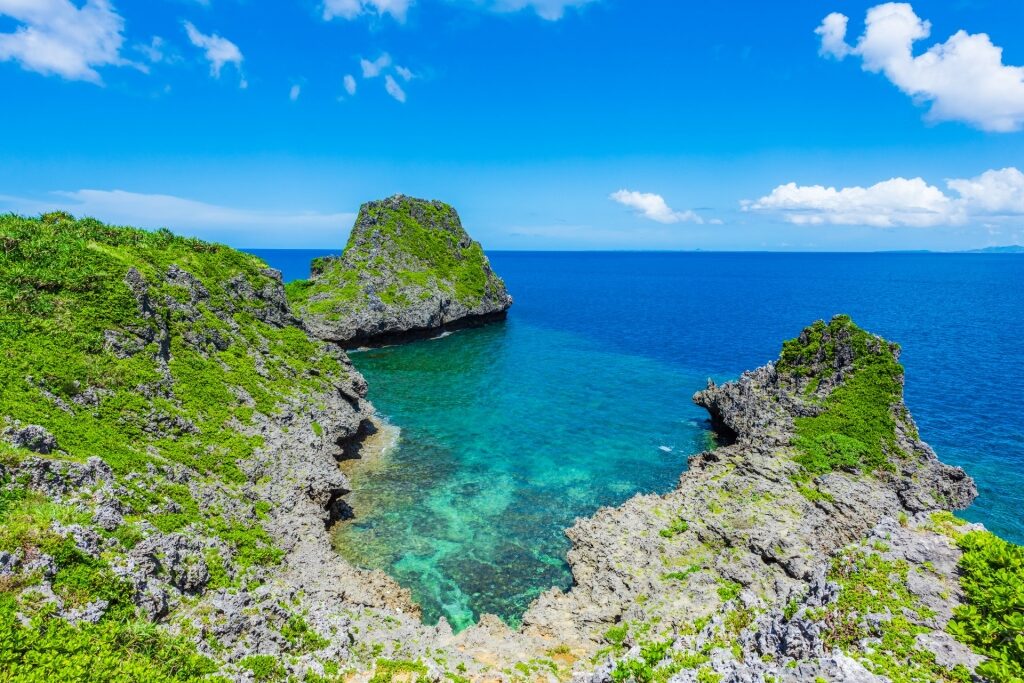
Cape Maeda, Onneto
Check sea conditions first, however, highlighted by warning flags at the top of the steps. Some visitors have tried diving from the cliffs, but this is very dangerous.
Nearby Maeda Flats is a better place for those wanting more of a traditional beach experience. It’s a long, sandy, much safer beach, again with good reef snorkeling, but in shallower waters.
Azama Sun Sun Beach, Nanjo
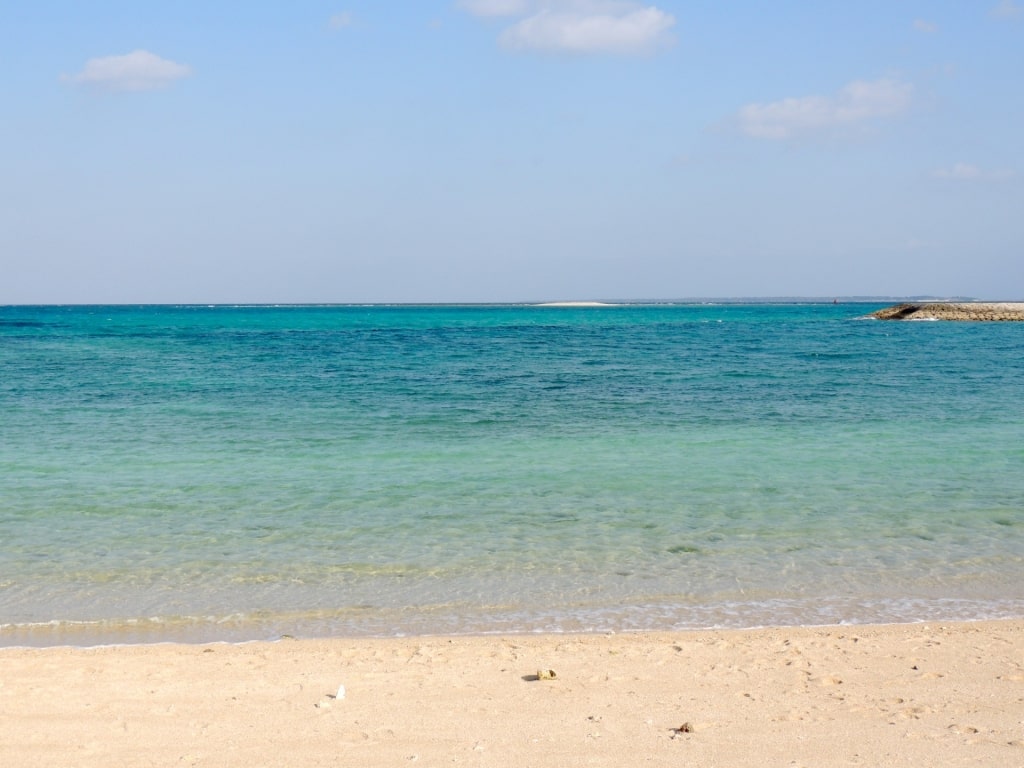
Azama Sun Sun Beach, Nanjo
Sometimes called San-San, this is a safe, shallow water beach. It’s 700 yards long, with a protected swimming area, and split in two by a jetty.
Behind it, like many of these urban Japanese beaches, is a park with picnic tables. There are also the usual barbecues, for which you buy food onsite.
You can rent all the usual equipment, including umbrellas and loggers. There is a wide choice of restaurants nearby.
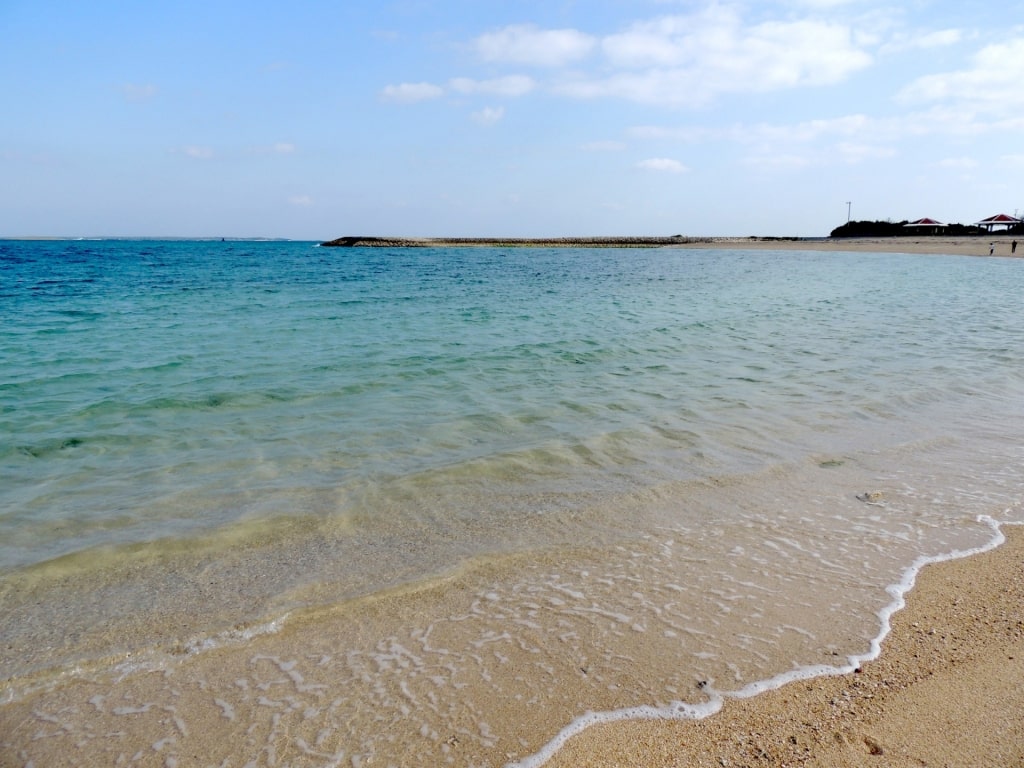
Azama Sun Sun Beach, Nanjo
It’s a place to kick back, relax and study the Okinawa belief in ikigai, or finding one’s purpose in life, or reason for being. Part of the secret of Okinawa’s famed longevity, a large part of ikigai is living in the moment.
Above the beach is a gentle seven-mile walking trail, also popular with runners. It takes you to peaceful Cape Chinen Park and back, with lovely ocean views, and a chance to check out the daring paragliders.
Ōdo Beach, Itoman

Ōdo Beach, Itoman
About 50 minutes from Naha, this beach lies on the southernmost tip of Okinawa Honto. It’s notable for its coral, and tropical fish, making it very popular with snorkelers.
This is a rocky coast, and low tide exposes a series of tidal pools. The coral rock is sharp, so bring a suitable pair of marine shoes if you want to go exploring.

Sea turtle
From March to August, you might be lucky enough to watch sea turtles coming ashore to lay their eggs. The beach is also known for diving and surfing, but facilities are fairly basic.
Odo beach is also known as “John Man Beach” after “John” Manjiro, whose ship landed here in 1850. Nakahama Manjirō, a fisherman, was one of the first Japanese to visit the US, living there from 1841 through 1850, after which time he returned to Japan.
Hyakuna Beach, Nanjo
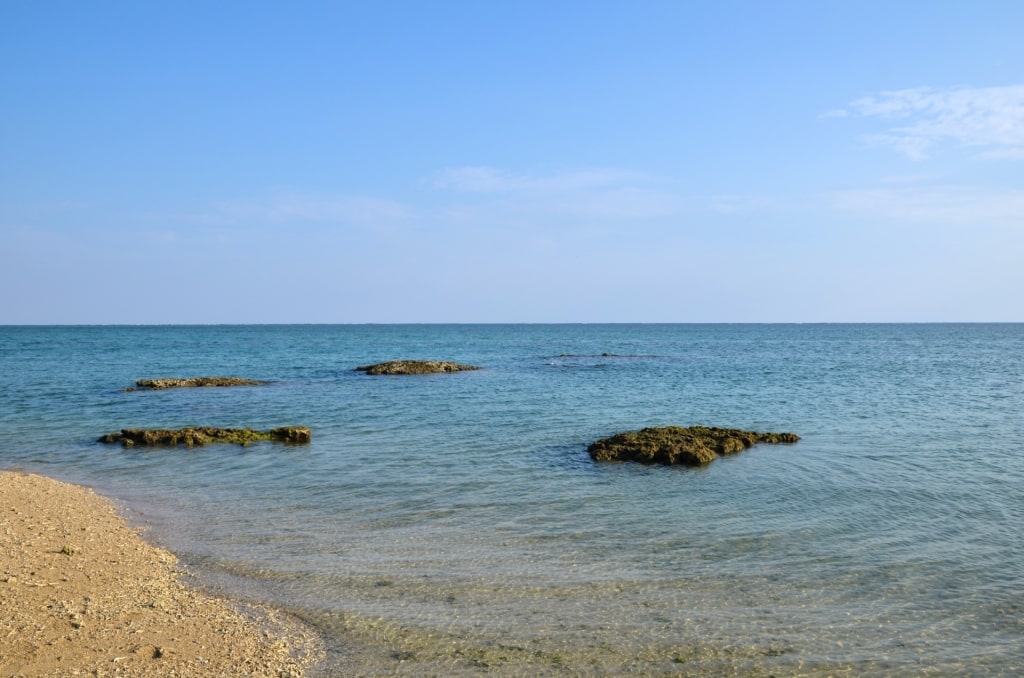
Hyakuna Beach, Nanjo
This beach on the southeast coast is very close to Mibaru Beach. It has similar white sand, and rock formations that stir the imagination.
On a clear day, you can see Kudaka, the rocky island where Amamikiyo first appeared. She is the goddess who, according to legend, created the Ryukyu Islands, now known as Okinawa.
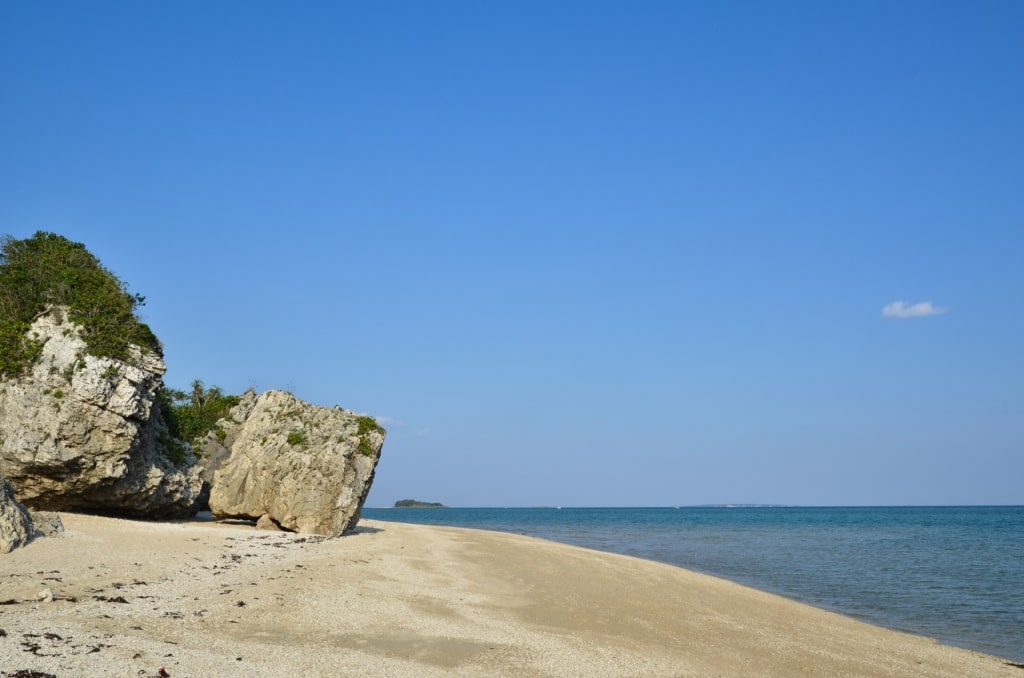
Hyakuna Beach, Nanjo
That connection, and its beauty, makes Hyakuna a popular spot for wedding photography. Whether you believe the legend or not, it’s a truly magical place.
However, don’t get too carried away as there is little shelter from the sun here. The coral sand is also hard on bare feet, so don’t forget your marine shoes or sandals before a stroll.
Gushichan Beach, Gushichan
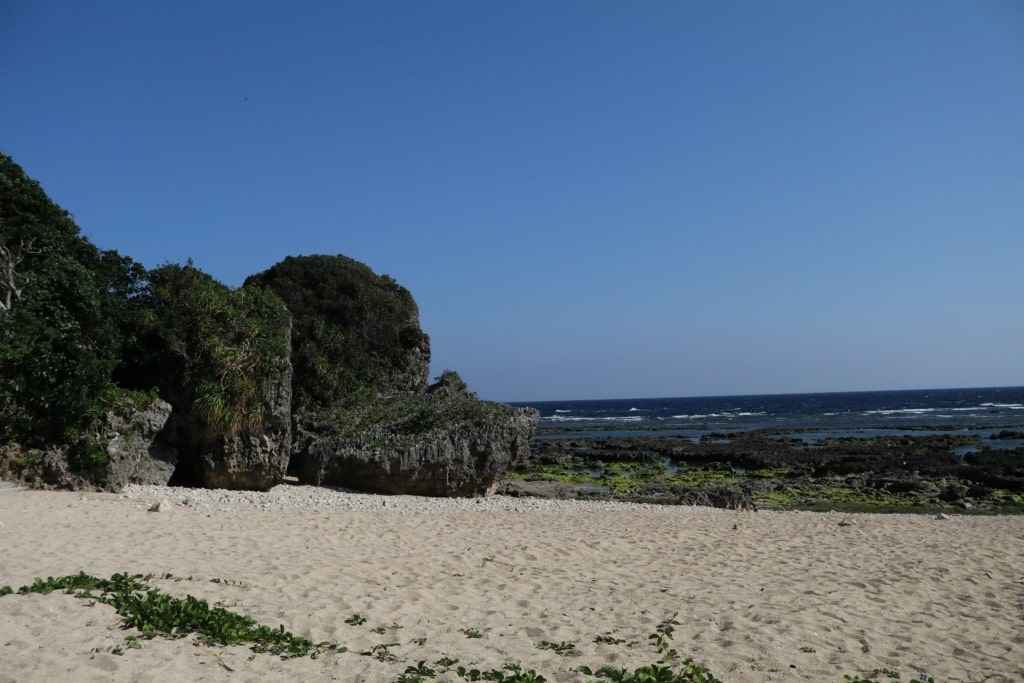
Gushichan Beach, Gushichan
If you are familiar with the Japanese love of “power spots”, places with special spiritual vibes, you’ll enjoy a visit to Gushichan Beach. It holds a heart-shaped rock that attracts believers in this updated variation on the Shinto connection to nature.
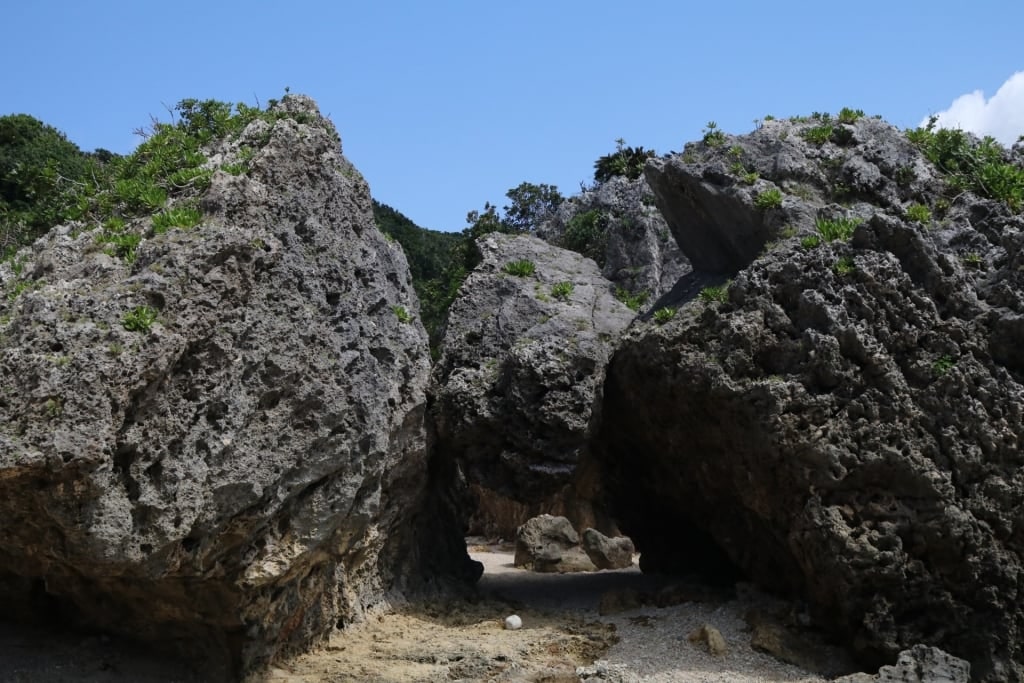
Gushichan Beach, Gushichan
It’s only one of many unusual rocks around this beach, popular also with those who love bouldering. However, there’s also enough sand to attract sunbathers or swimmers.
There’s the usual barbecue park but even more interesting is the Forest of Horohoro. This shady spot runs right down to the beach and is well worth exploring for its mature banyans and other trees.
Anyone with an interest in the WWII Battle of Okinawa will also want to visit the nearby Tomori Lion. It’s a stone statue, a talismanic “shisa”, that somehow survived the ferocious fighting in this area, and still bears the scars.
Araha Beach, Chatan
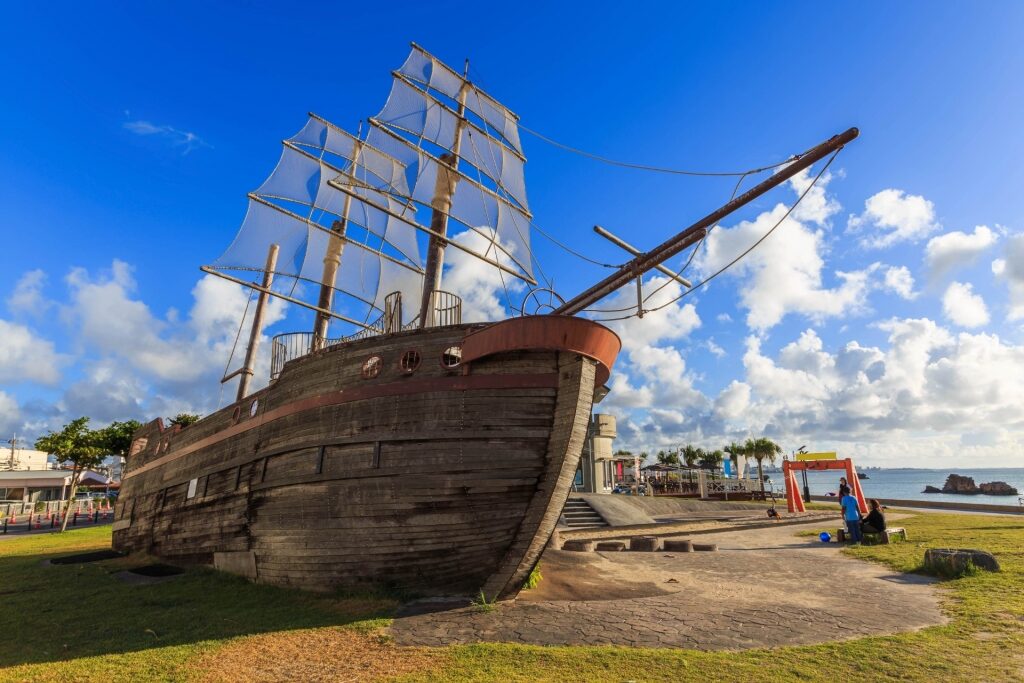
Araha Beach, Chatan
This long beach is north of Naha, along a curving stretch of coast facing west. A huge pirate ship—“Indian Oak”—beached in the sand tells you that a slightly unusual experience awaits.
Sadly, the ship is really for children, which does seem slightly unfair. However, adults can content themselves with beach volleyball and swimming, although there’s no snorkeling here.
Taking a glass bottom boat to look at the coral reefs is popular. The Taco Rice Café will also introduce you to the most famous US-Okinawan fusion food.
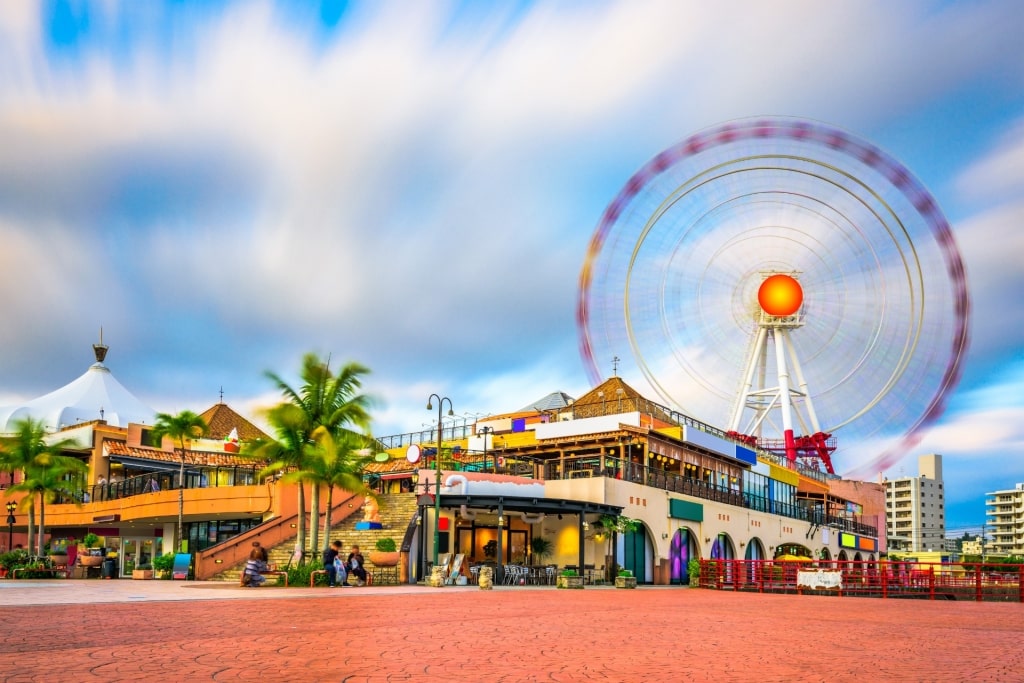
American Village, Chatan
A walking trail connects to Chatan Park, and the American Village—which is exactly what it sounds like, with shops, malls, and an amusement park. A good place for American food, drink or shopping, it’s also home to the interesting Akara Art Gallery.
Read: Best Things to Buy in Japan
Kabira Bay, Ishigaki Island
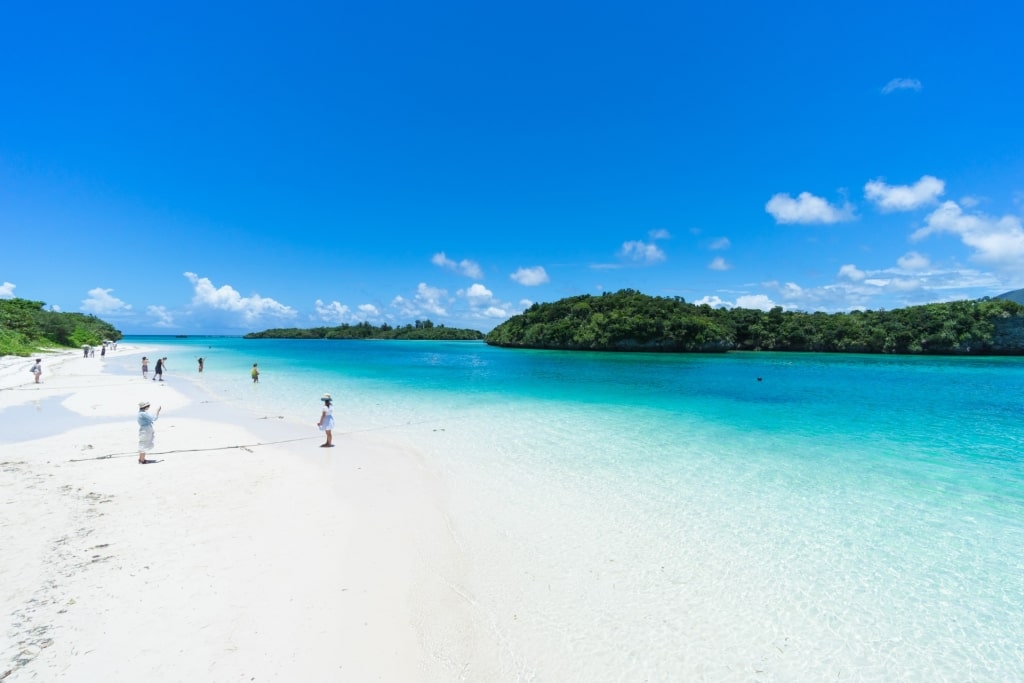
Kabira Bay, Ishigaki Island
Kabira Bay is one of the most beautiful sights in Japan. It’s an island paradise, perhaps experienced best from a glass-bottomed boat.
You’ll see rich coral, more than 100 types, and lots of fish life. Manta rays are a common sight, much beloved by local scuba divers.
The bay is part of Iriomote-Ishigaki National Park. Its white sand beach and clear turquoise waters form a picturesque contrast with the lush vegetation behind it.
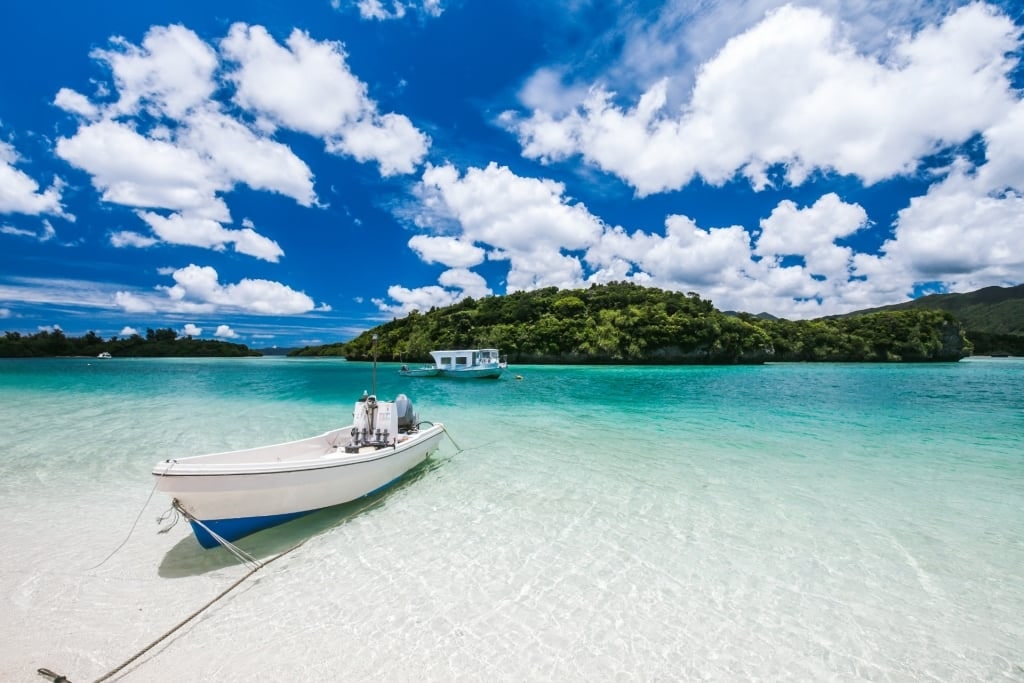
Kabira Bay, Ishigaki Island
A boat is, in fact, the only way to see the coral reefs, and tropical fish, as swimming is banned in the park except on some offshore islands. As well as preserving the coral, the ban also protects one of the only two places in Japan where black pearls are cultivated.
The bay is designated a Place of Scenic Beauty, together with Mount Omoto which overlooks it. But don’t worry, there are still plenty of restaurants, including a noodle parlor, and a gift shop.
Furuzamami Beach, Zamami
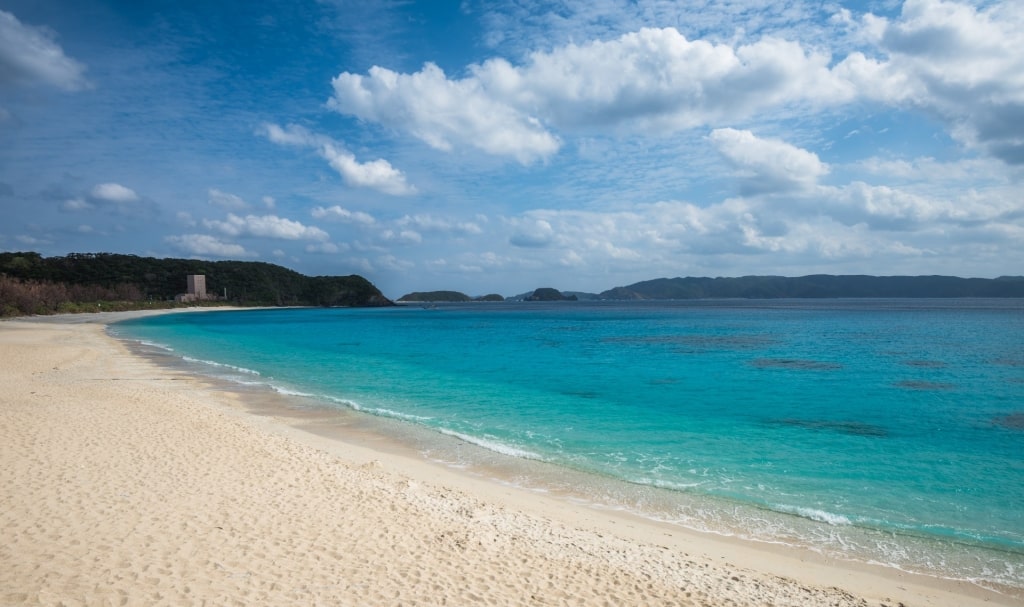
Furuzamami Beach, Zamami
Only 90 minutes from Naha by fast ferry, on Zamami Island, this is a beach at which you’ll be tempted to spend longer. Many people do, staying either in the campsite or local guesthouses.
It’s a beautiful stretch of white sand, facing the blue waters of the East China Sea. The fish life and coral make it a snorkeler’s paradise.
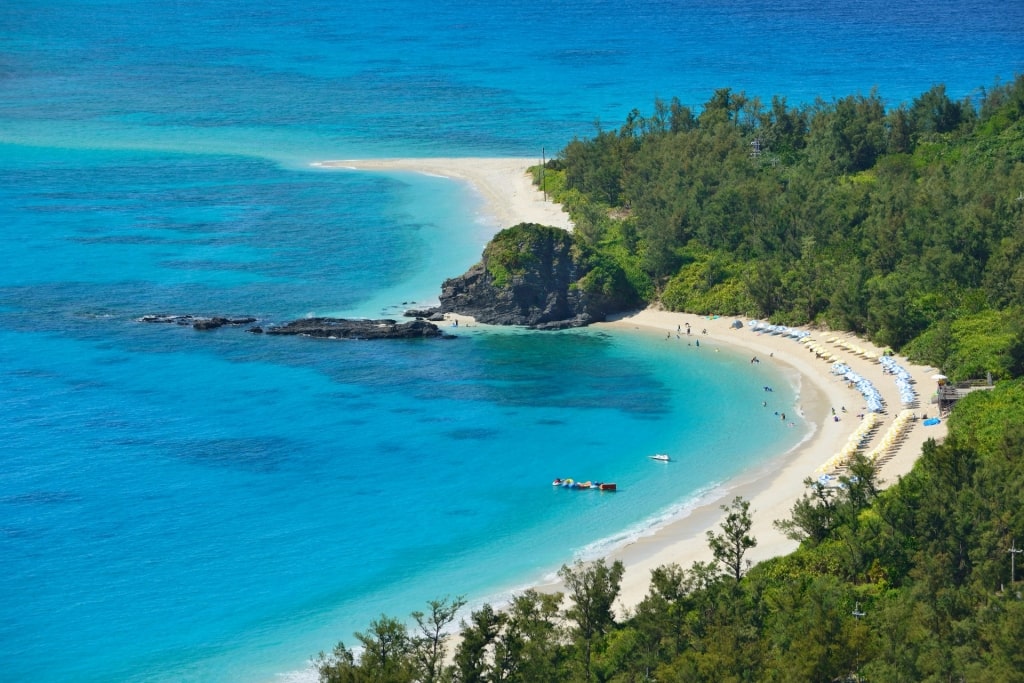
Furuzamami Beach, Zamami
You can rent snorkeling equipment and everything from beach towels to kayaks. Note that a major part of the lovely coral reef is protected, with swimming banned there.
Furuzamami is popular with day trippers, so it has every facility you can think of. Visitors from the US will want to see the Peace Monument and other memorials in Zamami Village, marking the first landings by US forces during World War II.
Read: What Is Japan Known For?
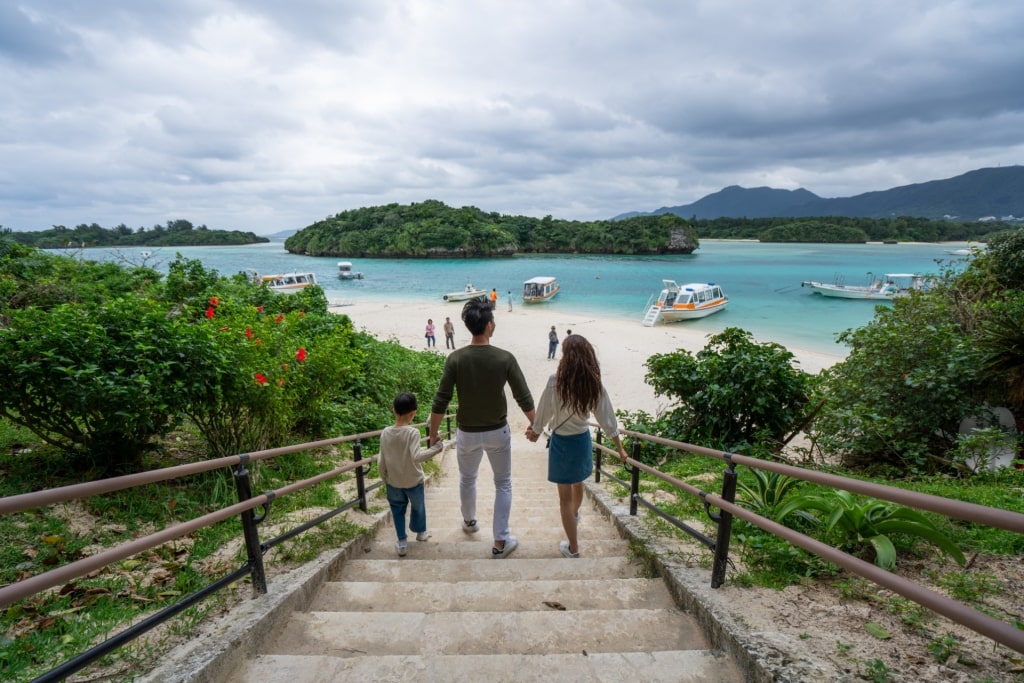
Kabira Bay, Ishigaki Island
Has this look at the finest Okinawa beaches inspired you to visit? Then browse Celebrity’s cruises to Okinawa to find the perfect vacation to open up all of the area’s wonders.



